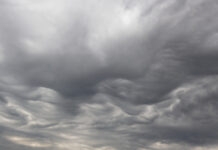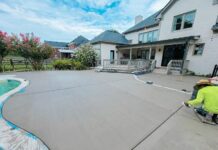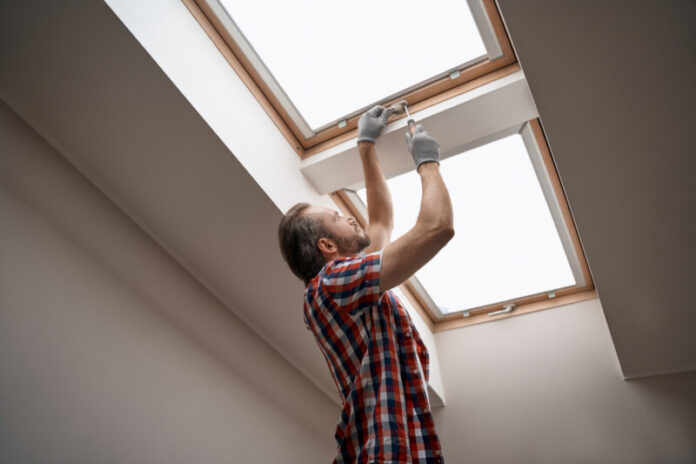If your house is feeling dark, gloomy, and a little cramped, a skylight could be a perfect addition to your space! Skylights let in five times more light than a regular window and illuminate your home with beautiful natural light. If you are looking to brighten up your place, find out as much as you can about the skylight installation process before you decide.
Pre-Installation
Before starting with your newest home project, a contractor will gauge to see if your roof is compatible with a skylight. Stick framed roofs built with rafters spaced four feet apart are well suited for skylights. However, it is not recommended to have a skylight installed on a truss-framed roof since cutting into a truss could inhibit the structural integrity of the roof.
Skylights can even be installed on flat ceilings through a different installation process by building a light shaft through your attic. Ask your roofing professional if a light shaft will work in your home.
Choosing your skylight
Skylights come in all different shapes, sizes, materials, and features to modify and meet your needs and style.
You can choose where the light in your home is projected from the shape and placement of the skylight. If you want the light in your home to expand wider, you can choose a shaft that is flared to spread the light.
When it comes to the light itself, this pseudo-window can be made from glass glazing or plastic glazing. Glass glazing is typically the better choice of the two.
Glass is scratch-resistant and heavy-duty, but can be the more expensive option for your skylight. However, that expense may pay off in the end. Due to its customizable properties, glass glazing can be tinted, cut and shaped, double-paned, and can prevent almost all UV light by adding a layer of argon gas in between double-panes. This keeps heat from escaping in the winter, and heat from entering in the summer.
Plastic glazing was a popular material for skylights in the 80s, since then, many advancements have been made in sky lighting materials. While plastic glazing is affordable and much lighter than its glass counterpart, it can scratch easier and has a tendency to discolor and turn yellow over time. Additionally, plastic does not have the ability to block UV light, nor can it be customized as it comes in standard shapes and sizes.
Location, location, location!
A skylight needs the perfect spot in your home to get its desired use. The perfect placement depends on both your preference and your roof’s qualities. Skylights work the best on a sloped roof in a room that is dark and directly below the roof like an attic or living space.
The direction of the skylight is mostly dependent on your preference. West-facing skylights will give your home beams of direct sunlight and may need to be filtered with a tint if you want to prevent afternoon heat.
North-facing skylights will give you consistent natural light throughout the day, while an eastern-facing skylight provides the best illumination for the morning light. A skylight facing the south side of your home can provide indirect solar heat in the winter but may need to be naturally shaded by trees, tinted, or feature an indoor shade to prevent overheating.
Additional Skylight Features
Skylights can be enhanced through different features.
A skylight shade can be installed just inside the skylight pane to counteract glare, prevent overheating, and give you more options for the type of light being filtered through your home. Shades can be motorized and controlled through a remote to get the perfect ambiance at the flick of a button or a cord can draw the shade open or closed with manual shades.
Skylights can be vented to provide fresh air circulation and naturally cool down rooms that are prone to run hot in your home. Like shades, vents can also be motorized or manually opened and closed.
Installation, cost, and timeline
A professional contractor will determine if your home fits the specifications for a skylight. They will walk you through your choices and set up an installation where a professional contractor will measure, cut, install, and seal your skylight.
Installation of a skylight can take anywhere from half a day to three days. Each project is different depending on the complexity of the skylight and your roof. Above all, check with an experienced roofing contractor to find out the cost and timeline associated when considering a skylight.
Trust the Pros
Leaks have long been a large concern for skylights. A professional job will be executed to prevent leaks as much as possible through multiple layers and techniques for sealing the skylight. Condensation buildup can mimic leaks since heavy condensation drips, which makes it seem like your skylight is leaking when it really is not.
No matter what type of skylight you choose to install, make sure your roof is in good condition to support this addition. If there are any obvious problems with your roofing structure or the materials, you want to get these taken care of before installing skylights. Get a free roof inspection from Roof Doctors, set up an appointment with a certified inspector online, or by calling 615-448-6349.
Have a question for Roof Doctors? Fill out the form below:
































